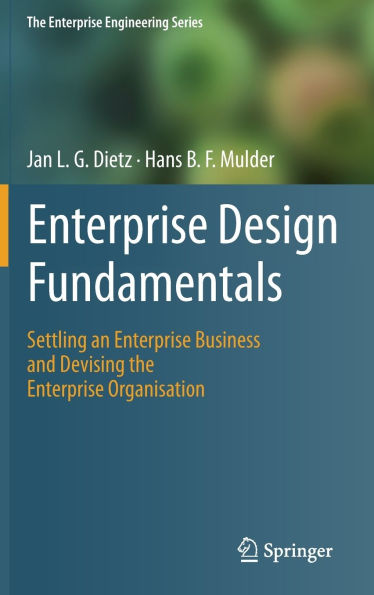To this end, the book is divided into three parts: Introduction, Theories, and Applications. Part I contains the three introductory chapters. In chapter 1 the reader is introduced to the discipline of Enterprise Engineering, in which a design-oriented view is taken toward organisations. Chapter 2 discusses the often-confused distinction between Enterprise Engineering and Enterprise Architecture, and chapter 3 introduces Enterprise Design as one of the conceptual pillars of Enterprise Engineering. Next, Part II outlines the constituting theories of Enterprise Design. Chapter 4 first provides an overview of all Enterprise Engineering theories and their position in a clarifying framework. Then chapters 5 through 10 contain extended summaries of the theories that underly the notion of Enterprise Design. Every chapter is divided in three parts: foundations, elaborations, and discussions. Eventually, Part III is about the application of the theories. Chapter 11 contains an extensive description of the DEMO (Design and Engineering Methodology for Organisations) methodology, specifically of the DAO method, which guides the (re)design of enterprises. In chapters 12 to 14 exercises are presented and discussed for the use of DEMO to the (re)design of enterprises. These exercises in organisational redesign and digital transformation are particularly suited as course material. In chapter 15, practical applications of DEMO in various industrial areas are reported.
In addition to a solid theoretical presentation of Enterprise Design, this book also contains many exercises and examples of its practical application. This combination makes the book perfectly suited for courses on Enterprise Design and Enterprise Engineering, including DEMO as the principal methodology in Enterprise Engineering.
To this end, the book is divided into three parts: Introduction, Theories, and Applications. Part I contains the three introductory chapters. In chapter 1 the reader is introduced to the discipline of Enterprise Engineering, in which a design-oriented view is taken toward organisations. Chapter 2 discusses the often-confused distinction between Enterprise Engineering and Enterprise Architecture, and chapter 3 introduces Enterprise Design as one of the conceptual pillars of Enterprise Engineering. Next, Part II outlines the constituting theories of Enterprise Design. Chapter 4 first provides an overview of all Enterprise Engineering theories and their position in a clarifying framework. Then chapters 5 through 10 contain extended summaries of the theories that underly the notion of Enterprise Design. Every chapter is divided in three parts: foundations, elaborations, and discussions. Eventually, Part III is about the application of the theories. Chapter 11 contains an extensive description of the DEMO (Design and Engineering Methodology for Organisations) methodology, specifically of the DAO method, which guides the (re)design of enterprises. In chapters 12 to 14 exercises are presented and discussed for the use of DEMO to the (re)design of enterprises. These exercises in organisational redesign and digital transformation are particularly suited as course material. In chapter 15, practical applications of DEMO in various industrial areas are reported.
In addition to a solid theoretical presentation of Enterprise Design, this book also contains many exercises and examples of its practical application. This combination makes the book perfectly suited for courses on Enterprise Design and Enterprise Engineering, including DEMO as the principal methodology in Enterprise Engineering.

Enterprise Design Fundamentals: Settling an Enterprise Business and Devising the Enterprise Organisation
353
Enterprise Design Fundamentals: Settling an Enterprise Business and Devising the Enterprise Organisation
353Hardcover

Product Details
| ISBN-13: | 9783031832611 |
|---|---|
| Publisher: | Springer Nature Switzerland |
| Publication date: | 05/06/2025 |
| Series: | The Enterprise Engineering Series |
| Pages: | 353 |
| Product dimensions: | 6.20(w) x 9.30(h) x 1.00(d) |
